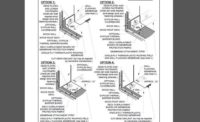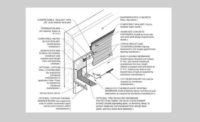
A Johns Manville self-adhered modified bitumen roofing system was judged to be the ideal solution for Athens Regional Medical Center. (Photo courtesy of Johns Manville.)
1. Cut out flashing materials that are unadhered, wrinkled or displaced until reaching adhered material.
2. Inspect the flashing for possible moisture infiltration.
3. If water infiltration is suspected, cut open the flashing and inspect the underlying interplies and substrate. Replace any wet or damaged materials.
4. To promote thorough adhesion of a patch, it is essential to begin by preparing the surface. Remove debris, contaminants, surfacing, ballast or loose granules from the surface of the membrane or flashing to be repaired. The area to be prepared should extend beyond the perimeter of the patch to provide an ample clean work area on which to install the patch.
5. Clean the surface of the membrane. If the membrane surface has been flood coated and aggregate embedded, carefully spud the aggregate free from the surface and sweep clean. The exposed asphalt flood coat may need to be heated with a torch in order to smooth out irregularities, then allowed to cool.
6. Prime the surface of the membrane with asphalt primer and allow it to dry. Primer contains solvents and is used to enhance adhesion; however, overuse of primer can harm the membrane.
7. Cut a patch of like material 8 inches larger in all dimensions than the defect to be repaired. Round the corners of the patch to a minimum radius of 3 inches.
8. Install the patch in hot asphalt, cold adhesive or by heat welding in accordance with the manufacturer’s recommendation over the repair area, extending 8 inches in all directions from any part of the defect. When using hot asphalt as the method of application, use Type IV asphalt and take care to maintain the asphalt at a minimum of 400 degrees Fahrenheit at the point of application. When torching, work gradually, applying heat only sufficient to achieve adhesion without damaging the membrane reinforcement or scorching surrounding membrane.
9. Apply moderate pressure to the patch to ensure adhesion to the existing membrane.

